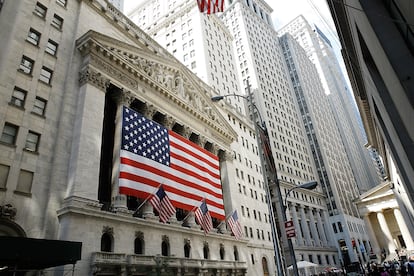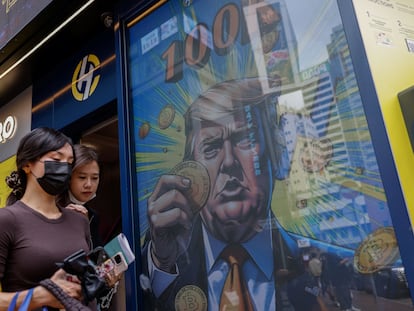Five signs of market excesses: What dangers lurk beneath the record highs?
Despite the high valuations, the U.S. stock market is still acting as a magnet for investors seeking opportunities (and often ignoring the risks)

A host of uncertainties are besetting the financial markets, and investors must take them into account when considering their options in the coming year, so that their investments do not turn into unexpected black swans. Exaggerated stock market valuations, as is currently the case in the United States; wild rallies in bitcoin and other cryptocurrencies with no economic backing; a concentration of profits and stock market rises in a small number of stocks that give a false sense of euphoria; public debt levels at record highs; and the political weakness of current European governments, with France at the forefront, at a time of growing geopolitical tension and with the global threat of trade war with the arrival of Donald Trump to power. These are the sources of tension in the market that should be setting off alarms among cautious investors.
1. S&P 500 valuations
Analysts have been repeating the mantra for more than a year that U.S. stocks are too expensive compared with the opportunities presented by Europe, but money stubbornly insists on investing on the other side of the Atlantic. Clément Inbona, a fund manager at La Financière de l’Échiquier (LFDE), believes that U.S. stocks are expensive from a valuation point of view, both relative to their own history and to the rest of the world and other asset classes. Several figures speak for themselves. “Currently, based on the famous price-to-earnings ratio (P/E) (the share price relative to earnings per share), European shares trade at a discount of close to 40% versus U.S. shares. He adds: “An investor is prepared to pay $22.5 for U.S. shares for $1 of earnings over the next year, whereas a company listed on this side of the Atlantic would cost him an average of just $13.5,” he explains.
In a recent article, the manager of Renta 4 Alpha, Alberto Espelosín, pointed to a P/E difference of eight points in favor of the U.S. stock market, which is a 20-year high and takes us back to the times of the dotcom bubble at the turn of the century. A difference that, in his opinion, has to do with the preeminence of the Magnificent Seven on Wall Street (Apple, Microsoft, Alphabet, Amazon, Nvidia, Meta and Tesla) due to better business margins and higher growth: before these stocks showed up, the P/E differential with Europe was only two points in favor of the U.S. markets. Undoubtedly, and despite the high valuations, the U.S. stock market is acting as a magnet for investors seeking opportunities in what will be the big trends of the future: technology and artificial intelligence. Europe, on the other hand, hardly has any technological giants capable of competing with those of Silicon Valley.
2. Crypto fever
Last Thursday bitcoin, the world’s first and leading cryptocurrency, managed to break through the $100,000 barrier. Donald Trump’s victory on November 5 has been key in this bullish rally, which started from $69,450 on Election Day. The Republican president-elect made a clear defense of cryptocurrency in his campaign, which he intends to incorporate into the country’s reserves, and this week he gave it a decisive boost by appointing Paul Atkins, a fervent advocate of eliminating obstacles to the crypto universe, as chairman of the SEC, the market supervisor. The State of Pennsylvania, for example, is preparing a bill that would allow it to invest up to 10% of its state contingency funds ($7 billion) in bitcoin, as a way of combating inflation and diversifying its investments. These measures represent the institutionalization as a financial asset of bitcoin and the other cryptocurrencies, which have reached a total capitalization of $3.05 trillion.
Dogecoin has been one of the best performing cryptoassets in recent times (it has doubled in price since the U.S. election), following the announcement that Elon Musk, the self-proclaimed “Dogefather,” will lead the Department of Government Efficiency (D.O.G.E) under the incoming Trump administration. Other memecoins such as Pepecoin and Bonk have also experienced very high gains. All in all, Trump’s victory has stoked the appetite for riskier assets, in an atmosphere of euphoria that ignores dramatic past episodes such as the FTX bankruptcy and the gingerly approach to cryptoassets shown by financial institutions such as the European Central Bank.
3. Focusing on the index
The U.S. represents almost 70% of the MSCI All Country World Index (MSCI), compared to a weight of 30% in the 1980s, although its current weight in the global economy is 27%. And in another demonstration of the concentration the markets are experiencing, the stocks of the Magnificent Seven comprise approximately 30% of the market capitalization of the S&P 500 index. “S&P 500 returns this year have been nothing short of spectacular, with the index rising an eye-popping 26% ytd (year-to-date). This stellar performance owes to a handful of technology stocks—the Magnificent 7—which returned 41% ytd and accounted for an astonishing 47% of the index’s gains, compared to just 18% for the remaining 493 stocks,” Goldman Sachs analysts explained in a recent report. The investment bank’s chief U.S. equity strategist, David Kostin, argues that investors do need to worry about market concentration over the long term: he forecasts an average annualized return for the S&P 500 of 3%, well below the historical average of 11% and 4 points below the 7% average that the model would suggest excluding market concentration.
The good performance of the U.S. market has gained further momentum with the victory of Donald Trump, who has been greeted with bullish sentiment over his proposals for less regulation and lower taxes. But his policies also have an inflationary risk, with steep import tariffs and immigrant deportations, which may lead to lower growth.
4. Public debt at record highs
The U.S. has just surpassed a public debt level of $36 trillion. Trump’s imminent return to power has put pressure on the debt market in view of his announced policies of tax cuts and increased spending, which are expected to increase the annual deficit and swell the debt figure. The market has already reacted with a rise in 10-year bond rates to around 4.2%, although they were close to 4.5% after the elections. The most pessimistic forecasts do not rule out that the U.S. bond will reach levels of 5%, which on other occasions has triggered stock market sell-offs.
Things are not much better in Europe, with debt at around 88% of GDP, which the International Monetary Fund (IMF) expects to become entrenched in the coming years. In the euro zone, the figures are very disparate: Greece’s public debt is equivalent to 163.3% of its GDP, while France’s has been at around 110% for the past two years and Spain stands at 104.4%. Others are well below these percentages: Germany (62%), the Netherlands (43%), Austria (81.6%) and Sweden (31.6%). The ECB is not complacent and recently warned of the risks facing the euro zone. “Heightened policy and geopolitical uncertainty, weak fiscal fundamentals and sluggish trend growth are heightening fears about the sovereign debt sustainability of some euro area countries,” it noted in its latest annual financial stability report.
5. Political risks
Last week, French Prime Minister Michel Barnier was brought down by a no-confidence vote in parliament after just three months in office. Political instability has led this major European economic engine to a significant increase in its risk premium compared to Germany, even above peripheral countries such as Greece, Spain or Portugal and only surpassed by Italy. “France, with a fiscal deficit of 6%, double the European average, and an economy in need of urgent reforms, is caught in a political storm that threatens to overwhelm the government and destabilize one of the pillars of the European Union,” explains Ignacio Dolz de Espejo, director of investment solutions at Mutuactivos.
Meanwhile, Germany is at a crossroads ahead of its next general election, due on February 23, following the collapse of the coalition led by Olaf Scholz. Europe’s largest economy has seen its structural problems pile up in recent years. It has gone from having affordable energy and importing cheap goods to export manufactured goods to Russia and China, to finding itself in the opposite situation. And it faces a deep industrial crisis, especially in the auto industry.
France and Germany are both facing political tensions that could spread to other countries in the Old Continent due to the lack of solid governments to tackle the imbalances in their economies and the threat of tariffs from the United States. The new year does not look set to be a placid one for investment in Europe, even less so if turbulence arrives from the other side of the Atlantic.
Sign up for our weekly newsletter to get more English-language news coverage from EL PAÍS USA Edition
Tu suscripción se está usando en otro dispositivo
¿Quieres añadir otro usuario a tu suscripción?
Si continúas leyendo en este dispositivo, no se podrá leer en el otro.
FlechaTu suscripción se está usando en otro dispositivo y solo puedes acceder a EL PAÍS desde un dispositivo a la vez.
Si quieres compartir tu cuenta, cambia tu suscripción a la modalidad Premium, así podrás añadir otro usuario. Cada uno accederá con su propia cuenta de email, lo que os permitirá personalizar vuestra experiencia en EL PAÍS.
¿Tienes una suscripción de empresa? Accede aquí para contratar más cuentas.
En el caso de no saber quién está usando tu cuenta, te recomendamos cambiar tu contraseña aquí.
Si decides continuar compartiendo tu cuenta, este mensaje se mostrará en tu dispositivo y en el de la otra persona que está usando tu cuenta de forma indefinida, afectando a tu experiencia de lectura. Puedes consultar aquí los términos y condiciones de la suscripción digital.
More information
Archived In
Últimas noticias
ChatGPT fails the test: This is how it endangers the lives of minors
The late consecration of women artists in their 90s
The Florida Keys tourist paradise is besieged by immigration agents: ‘We’ve never seen anything like this’
The latest scam on WhatsApp behind the legal dream: using immigration status as bait
Most viewed
- Families demand repatriation of bodies of Colombians who died in Ukraine: ‘This war is a slaughterhouse for foreigners’
- The low-cost creative revolution: How technology is making art accessible to everyone
- Liset Menéndez de la Prida, neuroscientist: ‘It’s not normal to constantly seek pleasure; it’s important to be bored, to be calm’
- Christian Louboutin: ‘Young people don’t want to be like their parents. And if their parents wear sneakers, they’re going to look for something else’
- ‘El Limones’ and the growing union disguise of Mexican organized crime










































